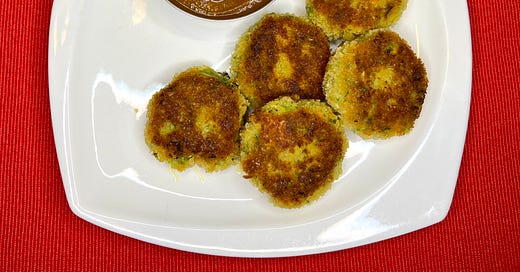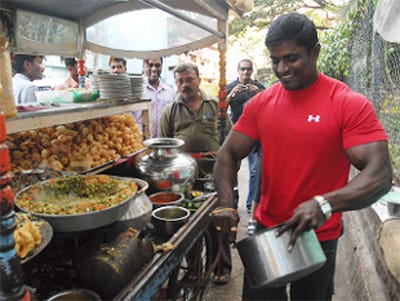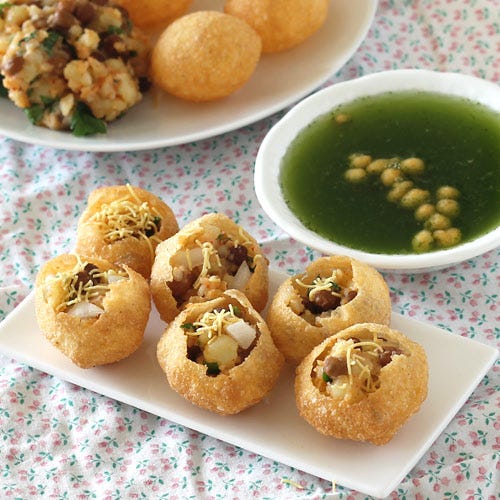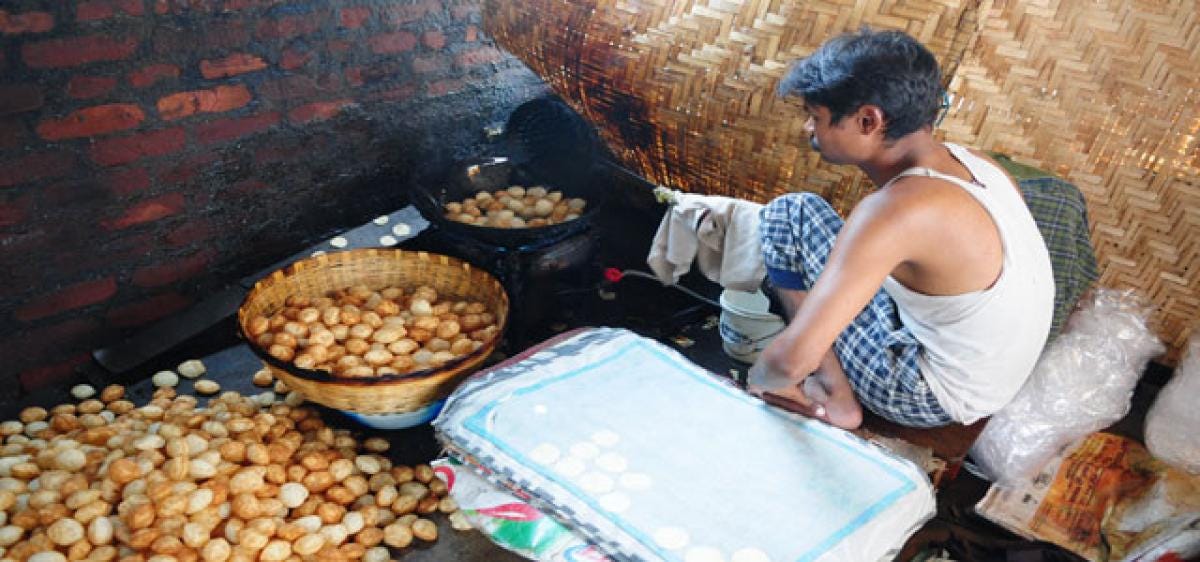I was 13 when I first tasted chaat. I was at my aunt’s for the weekend, break from boarding school. It had rained a bit, the air was cool and damp at dusk. My aunt suddenly asked if we wanted to go out for chaat. My cousins went crazy with excitement, but me, never having tasted it, was slightly more guarded in my enthusiasm. I didn’t have a particularly adventurous palate.
It was this little cart on one of the main roads a little way from my aunt’s house. We walked. The street wasn’t particularly well-lit, and there was not much traffic. A fairly typical Saturday evening in the then sleepy Bangalore. I was met by this exquisite aroma, a combination of petrichor, kerosene from the lamp that provided the sole light for the vendor’s cart, hurricane lamps, we called them, and spice. A vat of curried chickpeas simmering, bordered on one side by a mountain of little crisp, poofy round things. Crispy, crunchy pooris, my aunt told me. Hmmm…to me, pooris were poofy and soft; they were crunchy when they were stale. Didn’t do much for my enthusiasm. Then the various chutneys, and smaller mountains of chopped onion, cilantro, tomatoes, near larger mounds of the uncut vegs. What’ll it be first, my aunt asked. I was a bit perplexed. First? And I have no idea. Why don’t you try bhel poori first, my aunt suggested; it is puffed rice, mixed with lots of different things. And do you want it spicier or sweeter? Or a mixture of sweet and spicy? I got a mixture. I had no idea what to expect, but watched the vendor deftly and incredibly rapidly dip his hands into the small mounds of ingredients, and, with almost a nonchalance, yet a deliberateness, mix a huge assortment of ingredients together in his large mixing bowl, a bit of this, a bit of that, and of course, some of the green chutney, some of the brown chutney. And except for the chutneys, the man used his fingers for everything else. Mesmerizing to watch. That first bite was nothing short of magical. I devoured the small plateful, wishing there was more.
Not my chaat vendor, but mine was not too different
Slightly fancier chaat cart
So what next, came my aunt’s voice. Next? I’m allowed more? Something different, she suggested. How about pani poori? Oh, so that’s what the little crispy pooris were for. And this time, I watched in stupor as the vendor, again, with lightning speed, first used his thumb to make a small hole in one of the pooris, then filled it with curried chickpeas, various diced veggies, and then dipped it first in the green chutney, then the brown chutney, then into what looked like dirty dish water. The pani part of the pani poori. Then proceeded to put that small, almost exploding poori onto my plate. Try and eat it in one mouthful, my aunt advised. And oh lord, what a mouthful that was. An explosion of hot and cold, crisp and soft, sweet and spicy. The most perfect combination of textures and flavors ever, albeit enormous. And the dirty dish water was truly exquisite. Tasted of cumin, mint, cilantro, chilli, salt…. And then the process was repeated. 7 more times, I think – there were 8 pooris to a plate of pani poori.
Pani poori vendor
Pani poori at a fancier establishment than the humble street cart
I have eaten pani poori hundreds of times since then, made it as many times, but never have I eaten as perfect a mouthful as that first one.
Indian street food. To me, chaat is synonymous with Indian street food, though it is but one kind among dozens. Comes from the Hindi verb chaatna, which means to lick. So literally, food that is finger-licking good. There are many, many different kinds of chaat, some made with puffed rice, some with crisp pooris, both poofy and flat, some with samosas, some with potatoes, all with at least two different kinds of chutneys, one spicy, and the second, sweet. And this is the savory chaat. There are also fruit chaats – fruit salads, if you will, but flavored with some Indian spices. Of course. Chaat is popular all over India, and the larger cities have rivalries over whose fare is best. Again, of course. And in addition to chaat, other kinds of street food include more regional fare, both linguistically and culinarily extremely diverse: chole bhatura, a very poofy and soft poori served with a chickpea curry, dosas and idlies of various kinds in the southern states, Indian Chinese fare everywhere, and of course, loads of different kinds of kebabs, particularly in areas of India where there are larger Muslim populations.
How brilliant is this? Doesn’t come anywhere close to the diversity of actual offerings in different parts of India, but hey!
Street food in India was, and continues to be, a necessity. Why? Because it serves everyone. It serves day laborers. It serves migrants, seeking their fortunes in the bigger cities, where unprecedented urban growth and an exponential increase in labor force to support this growth. And in a country with a population of 1.3 billion, there are a hell of a lot of migrants, and street food has been their sole source of nourishment. It is fast, and for the most part, healthy (in urban India, even the dirty dishwater is made of bottled water these days; and while my very westernized digestive system won’t take as much as I’d like it to, the people most street vendors cater to are fine; in India today, I just have to know where to go) because it is cooked fresh and the turnover is incredibly rapid. And doesn’t cost much to make. But most importantly, it tastes bloody good.
In the last decade or so, Indian street food has received attention from the more…er… elite circles. And it has become more acceptable, more fashionable to eat it. As I mentioned lawt week, it is a leveler of sorts. Even Netflix has at least one show exclusively on street food. One episode focuses on Delhi, and a particular chaat seller. His cart, I saw, was not substantially different from the vendor near my aunt’s house in the mid-80s, except for the kerosene lamp being replaced by a few electric bulbs. And I attribute the increased attention street food is getting partly to, well, good food. Today, in India, there is even a National Association of Street Vendors, whose chairperson emphatically says that the most authentic food in India is street food. I don’t doubt the veracity of that statement, despite the source. And the government’s influence on street vendors…well, that’s the subject of a much different, possibly future post.
And irrespective of where it comes from, all street foods are humble. Cooked in the most humble of spaces, hard to call them kitchens, using the most humble equipment. Usually a cutting board of sorts, a huge knife used for everything, from peeling a single tiny clove of garlic to chopping huge bundles of cilantro, giant vats made of either stainless steel or aluminum. And often a one-burner stove. Or two, if the vendor is more fortunate.
Next to street food in a dictionary ought to be the word unpretentious.
Vendor making poori on a one-burner stove.
And watching shows about street food, what always strikes me is how humble kitchen spaces and equipment are used to create the most exquisite food. Where am I going with this?
Here.
The global kitchenware market was estimated at USD 59.3 billion in 2019, and is expected to reach 77.5 billion by 2025, with the cookware product segment dominating world markets. Cookware products? Huh? You know, crockery, cutlery, and then the numerous tools one can use in a kitchen. From the basic, blenders, food processors, whisks, to you know, the latest in er… garlic peelers or presses, or butter curlers, or bacon flatteners. Or whatever else the cookware industry deems necessary for the home cook. There are loads of lists of stupid inventions – that people, nonetheless, buy. Here’s an example. And here is another. I mean, seriously, an iKettle 2.0? Ooh, even better, the egg cuber! And how have I managed all these years without a $180 travel coffee mug?? It keeps my coffee at exactly the right temperature!
And while till a few years ago, cookware of this kind in India wasn’t a big thing, today, it most certainly is, with India’s elite rushing to furnish their kitchens with the latest trends, their choices being dictated by the William Sonomas, the Sur la Tables of the world, or in India, places like Thinkitchen, which sell INR 2000 peelers and graters and INR 1200…wait for it…spoon rests. And the urban Indian consumer flocks to these places.
All while cooking far less frequently.
So we’ve gone from humble to, well, not humble. But the best food still comes from the humble, often make-shift kitchen. I wonder how many INR 800 potato mashers the average chaat wallah owns.
Is it gullibility? Stupidity? Greed? Consumption. The name of the game. The fancy coffee mug is on my birthday wish list.
Not.
But if you’ll excuse me, I must go and determine just how many appliances or gadgets I have in my kitchen that I never use.
And while I most certainly won’t go all puritanical about my relationship with the cookware industry, I mean, there’s nothing wrong with some modern comforts, thinking back to some of my favorite eating experiences ever, well, does give me pause.
So today I will give you a recipe for one of the key ingredients in chaat – the date and tamarind chutney. Over the years, I have made many versions of this, and have come down to this version – with fewer ingredients than I used to use. But to me, a more simple and pure taste. This is a chutney that can be eaten with anything that needs a dip. Or it can be used to baste meat or chicken with for a BBQ – an Indian BBQ sauce, if you will. Or it can be used as a spread on a sandwich. Endless possibilities, simple ingredients. And ridiculously simple to make.
Oh, and isn’t it interesting that we called (and still do) them hurricane lamps, and not cyclone lamps?
Date and Tamarind Chutney
Ingredients (makes about 2 cups of chutney; vegan; vegetarian)
1. 1 cup pitted dates
2. 1 green cardamon pod
3. 2 cloves
4. 2 ½ Tbsp tamarind paste - same kind I used a couple of weeks ago
5. ½ tsp cayenne pepper – or more to taste
6. 1 cup water
Method
1. Boil the dates, cardamon, and cloves together for about 10 minutes with ½ cups of water. Boil for a wee bit longer if your dates are drier. The dates should soften and be easily blendable.
2. Blend the boiled dates and spices, the tamarind paste, and the cayenne together with an additional ½ cup of water till good and smooth. If you think the chutney is too thick, add a wee bit mor water.
3. The chutney is a fantastic accompaniment to the potato bondas we made many weeks ago.
When I made this earlier this week, I served them with vegetable cutlets, which is what we call vegetable patties (what you might call a veggie burger) in India. To my joy, my older child loved them! He ate six, I think, and wanted them for his lunch the next day! The younger child tolerated them. But hey, I’ll take it! And cutlets and chutney would definitely be chaat.
Note: As I mentioned a few weeks ago, the tamarind paste I use has salt in it. If what you are using doesn’t have salt in it, add ½ to ¾ tsp of salt to the blender while blending the ingredients.











